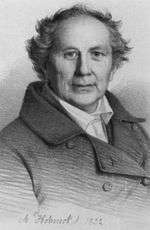Friedrich Wilhelm Argelander
Friedrich Wilhelm August Argelander (22 March 1799 – 17 February 1875) was a German astronomer. He is known for his determinations of stellar brightnesses, positions, and distances.
Friedrich Wilhelm Argelander | |
|---|---|
 Friedrich Wilhelm Argelander | |
| Born | 22 March 1799 |
| Died | 17 February 1875 (aged 75) Bonn, Germany |
| Nationality | Prussian |
| Alma mater | University of Königsberg |
| Awards | Gold Medal of the Royal Astronomical Society (1863) |
| Scientific career | |
| Fields | Astronomy |
| Doctoral advisor | Friedrich Wilhelm Bessel |
Life and work
Argelander was born in Memel in the Kingdom of Prussia (now Klaipėda in Lithuania), the son of a father of Finnish descent, Johann Gottlieb Argelander, and German (Prussian) mother, Dorothea Wilhelmina Grünlingen.[1] He studied with Friedrich Bessel, and obtained his Ph.D. in 1822 at University of Königsberg. From 1823 until 1837, Argelander was the head of the Finnish observatory, first in Turku and then in Helsinki. He then moved to Bonn, Germany. There he designed and built a new observatory at the University of Bonn with funding approved directly by King Frederick William IV whom Argelander had become friends with in his childhood. (This lifelong friendship started when the then crown prince temporarily lived in Argelander's parents house after the Prussian royal family fled to Memel after the Battle of Jena–Auerstedt during the Napoleonic Wars.)
Argelander excelled in developing effective, simple and fast methods for measuring star positions and magnitudes, thereby making a pioneering work for modern astronomy. He also measured star distances with heliometers. His, and his collaborators', great practical works of star cataloging and variable star research were made possible by the systematic usage of then newly developed techniques.[2]
Argelander was the first astronomer to begin a careful study of variable stars. Only a handful were known when he began, and he was responsible for introducing the modern system of identifying them.[3] He also made a rough determination of the direction in which the Sun was moving.
In 1842, he discovered that Groombridge 1830 had a very high proper motion. For many decades its proper motion was the highest known; today it still occupies third place. For a time, it was known as Argelander's Star.
Together with Adalbert Krüger and Eduard Schönfeld, Argelander was responsible for the star catalogue known as the Bonner Durchmusterung, published between 1859 and 1862, which gave the positions and brightness of more than 324,000 stars, although it did not cover much of the southern half of the sky. This was the last star map to be published without the use of photography.
In 1863, Argelander helped lead in the founding of an international organization of astronomers named the Astronomische Gesellschaft.
Honors and legacy
- Elected a foreign member of the Royal Swedish Academy of Sciences in 1846.
- Elected a Foreign Honorary Member of the American Academy of Arts and Sciences in 1855.[4]
- Elected Member of the Royal Academy of Science, Letters and Fine Arts of Belgium.[5]
- Was awarded the Gold Medal of the Royal Astronomical Society in 1863.
- Orden Pour le Mérite für Wissenschaften und Künste (Order Pour le Mérite for Arts and Sciences - Civil class) in 1874.[6]
- The three astronomical institutes of the Bonn University were merged and renamed as the Argelander-Institut für Astronomie in 2006.
- The crater Argelander on the Moon and the asteroid 1551 Argelander are named for him.
Further reading
- Argelander, Friedrich Wilhelm (1822). Untersuchung über die Bahn des grossen Cometen vom Jahre 1811,[7] 4, Königsberg
- Asimov, Isaac (1972). Asimov's Biographical Encyclopedia of Science and Technology. Doubleday & Co., Inc. ISBN 0-385-17771-2. (Parts of this article are based on this source.)
- Sticker, Bernhard (1970). "Argelander, Friedrich Wilhelm August". Dictionary of Scientific Biography. 1. New York: Charles Scribner's Sons. pp. 240–243. ISBN 0-684-10114-9.
See also
References and notes
- Citations
- Hockey, Thomas (2009). The Biographical Encyclopedia of Astronomers. Springer Publishing. ISBN 978-0-387-31022-0. Retrieved August 22, 2012.
- "F. W. A. Argelander". Archived from the original on 2017-01-12. Retrieved 2008-05-20. (in German)
- Chapman, David M. F. (February 1999). "Reflections: F.W.A. Argelander - Star Charts and Variable Stars". Journal of the Royal Astronomical Society of Canada. 93: 17. Bibcode:1999JRASC..93...17C.
- "Book of Members, 1780-2010: Chapter A" (PDF). American Academy of Arts and Sciences. Retrieved 22 April 2011.
- Index biographique des membres et associés de l'Académie royale de Belgique (1769-2005) p16
- "Orden Pour le Mérite".
- Tr. Research into the orbit of the great comet of the year 1811
External links

| Wikimedia Commons has media related to Friedrich Wilhelm August Argelander. |
- Günther, Siegmund (1902), "Argelander, Friedrich", Allgemeine Deutsche Biographie (ADB) (in German), 46, Leipzig: Duncker & Humblot, pp. 36–38
- W.T.L. (1876). "Obituary". Monthly Notices of the Royal Astronomical Society. 36: 151–155. Bibcode:1876MNRAS..36..151.. doi:10.1093/mnras/36.4.151. Retrieved 2008-05-20.
- Neue Uranometrie, 1843 - Full digital facsimile, Linda Hall Library.
- Uranometria nova, Berlin 1843